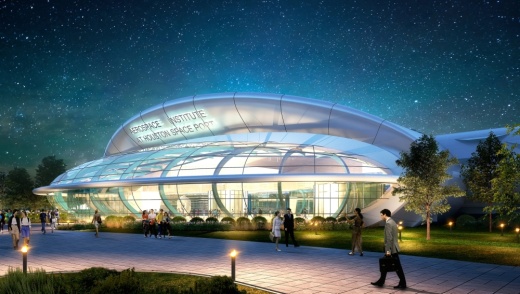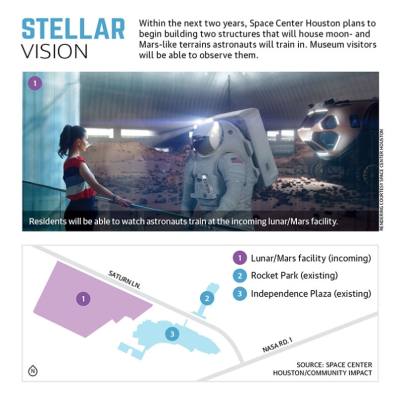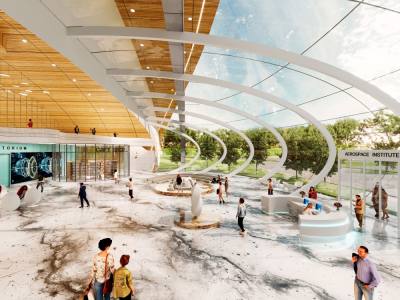NASA astronauts Reid Wiseman, Victor Glover and Christina Hammock Koch as well as Canadian Space Agency astronaut Jeremy Hansen are those picked to fly around the moon during the Artemis 2 mission, which will make way for humans’ return to the lunar surface and, eventually, Mars.
But as the world looks to the stars, plenty of space-related developments are occurring on Earth in the Bay Area as well.
The Houston Spaceport along Space Center Boulevard in Clear Lake is on the verge of expansion as it fills with aerospace companies. The spaceport is a hub for businesses furthering space exploration.
“Today, the mission and the vision as a community, it’s being executed in a fantastic manner that I think challenges every spaceport development across the nation,” Houston Spaceport Director Arturo Machuca said.
Meanwhile, NASA’s Johnson Space Center’s museum, Space Center Houston, is planning major upgrades that will give visitors a more personal look at astronaut training. The center is designed to show the public what occurs at NASA.
“[The spaceport’s] expansion plans and our expansion plans, they complement each other so nicely, and they are just again an indicator of how popular and interesting space is to so many,” said Keesha Bullock, Space Center Houston’s chief communications and marketing officer.
Spaceport’s rapid growth
Machuca never thought the spaceport would grow so fast.
Sitting in Ellington Airport, the Houston Spaceport was officially licensed as the nation’s 10th spaceport in 2015. The idea behind it was to create a hub for aerospace companies to work together and with NASA to further the nation’s exploration of space.
The spaceport truly got underway when Phase 1 finished in late 2019. During this phase, at a cost of about $24 million, about 150 acres of spaceport land was filled with the infrastructure necessary to attract aerospace companies.
Now, 3 1/2 years later, Phase 1 is almost completely filled with aerospace companies, making expanding with Phase 2 necessary, Machuca said.
“All of the sudden, we find ourselves in this sweet problem, I’d say: We are somehow running low in offerings in terms of land,” he said.
Phase 2 will be about 300 acres, and its infrastructure is estimated to cost $80 million. Expected to break ground in the next 12 to 18 months, Phase 2 will include parcels for other aerospace companies to locate to the spaceport. Machuca said spaceport officials are in “serious conversations” with three such undisclosed companies.
In addition, Phase 2 will include land for a hotel, restaurants and retail centers to make the spaceport a destination. The spaceport will eventually include a terminal that will allow residents to fly on hypersonic jets to reach faraway destinations in a fraction of the time it takes today, Machuca said.
Another unique project slated for Phase 2 is the Aerospace Institute.
At the EDGE Center within Phase 1 of the spaceport, San Jacinto College and other higher education institutions help train students how to work in the aerospace industry. The institute will be a continuation of that idea and involve more local colleges to make sure the spaceport has capacity to train the next generation of aerospace workers, Machuca said.
During a presentation Johnson Space Center Director Vanessa Wyche gave April 26, she echoed the importance of partnering with colleges to expose students to the aerospace industry.
“Here locally, [at] the spaceport, we have had such an increase in activity we have had the need for additional workforce [development],” she said.
Today, Phase 1 includes Collins Aerospace, which opened in September 2022 and is helping develop NASA’s next generation of spacesuits; Axiom Space, which is under construction and will create the first private space station and is also helping develop spacesuits; and Intuitive Machines, which is also under construction and is responsible for building a lunar lander that is scheduled to go to the moon this June ahead of Artemis 2.
The companies will bring as many as 1,800 jobs to the area in addition to $4 billion worth of contracted work over the next decade, Machuca said. Spaceport officials expect to hold ribbon-cutting ceremonies for Axiom and Intuitive Machines by the end of September, Machuca said.
There is room for smaller companies to squeeze into Phase 1 to work alongside the larger ones. Spaceport officials are also considering finding an investor to build a hub building that smaller companies could lease space from so they don’t have to build their own spaceport facilities, Machuca said.
Paving the way
Spaceport officials are already considering ways to expose the public to the spaceport.
The Houston Airport System, Harris County Precinct 2 and the city of Houston are working together on a project to build a road through the middle of the spaceport. This road would divert traffic from Space Center Boulevard through the spaceport to connect to Hwy. 3, Machuca said.
Today, Space Center Boulevard moves through residential areas, so this new road would not only divert ever-growing traffic through the spaceport but also expose commuters to it, he said.
Additionally, officials are considering a public transit hub to help further connect the spaceport to San Jacinto College where EDGE Center students attend college, the adjacent neutral buoyancy lab where astronauts train, and the Johnson Space Center where NASA employees work, Machuca said.
“We just don’t want to build a manufacturing site that doesn’t contribute positively to our community,” Machuca said.
Scott Spiegel, senior press secretary for Harris County Precinct 2 Commissioner Adrian Garcia, said Garcia recognizes the importance of the spaceport and surrounding area to the region’s future.
“He looks forward to working with the city of Houston and other local partners to determine that appropriate infrastructure needs in the region are met,” Spiegel said in a statement to Community Impact.
“Ellington Bypass Road could prove to be an important piece to the spaceport’s needs, and we look forward to seeing the city of Houston preliminary engineering report.”
Furthermore, work will soon begin on a new taxiway to the northwest of phases 1 and 2. This runway will allow aircraft to take off and land right next to aerospace companies, such as Axiom, which will use the taxiway to unload parts for the space station it is building, Machuca said.
Spaceport officials are on the verge of announcing the contractor for the taxiway project. The plan is to build the northern half of it to start at an estimated cost of $130 million, Machuca said.
But the expansion of Clear Lake’s outer space identity doesn’t stop there.
Museum expansion
Space Center Houston, now 30 years old, aims to give residents an inside look at the past, present and future of space exploration and what happens at NASA’s next-door Johnson Space Center. The museum’s mission to bring people and space closer together will advance with the museum’s planned next steps, said William Harris, president and CEO of the museum.
The center plans to create the Lunar Mars Surface Integration Facility—two large enclosed structures that will simulate the terrains of the moon and Mars. Visitors will be able to watch from an elevated exhibit hall as astronauts donned in spacesuits train in the two structures.
The structures will be designed to simulate the lunar and Mars environments as close as possible to reality, so they will be heated or cooled to various temperatures to simulate, for instance, the dark and light parts of the moon. Additionally, astronauts and any equipment they use, such as lunar landers or rovers, will be fastened to a hydraulic pulley system to simulate the celestial bodies’ gravities, Harris said.
Designing the facility, which may break ground within the next two years, has been a collaborative effort.
“We did more than 40 workshops with scientists, engineers, commercial partners, government [and] educators. What evolved was a facility that could meet the needs of many of them, which became the Lunar Mars Surface Integration Facility,” Harris said. “My vision for Space Center Houston is that we’re a convening place where we bring together the government, the commercial, ... the academic and the community, and that this is a center of learning.”
Commercial companies, like ones at the spaceport, will be able to use the facility to create and test new technologies in an environment they wouldn’t otherwise be able to create, Bullock said.
“To be able to see astronauts in training, to see commercial companies developing their new technologies ... right in front of your eyes ... is something that you really aren’t going to be able to see anywhere else,” she said.
The new facility will add at least 60,000 square feet of exhibit space to the existing 120,000 square feet. That will increase capacity for guests, some of which are not able to participate in the museum’s offerings due to space constraints, Harris said.
“That’s unacceptable to me,” he said. “I want to be sure every kid that wants to participate can.”









